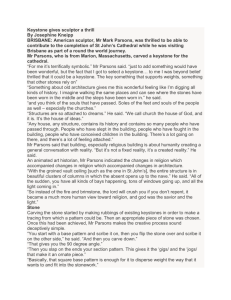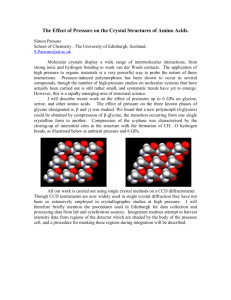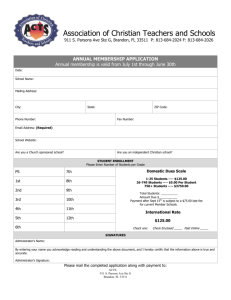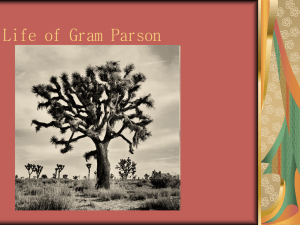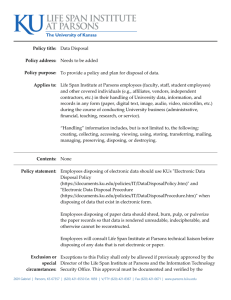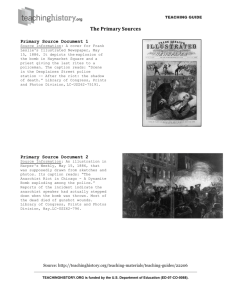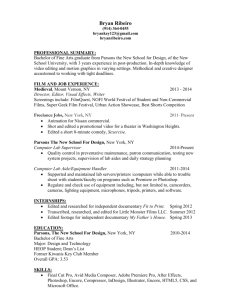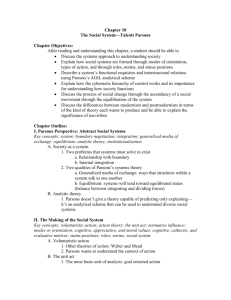Albert Parsons Lesson Plan
advertisement
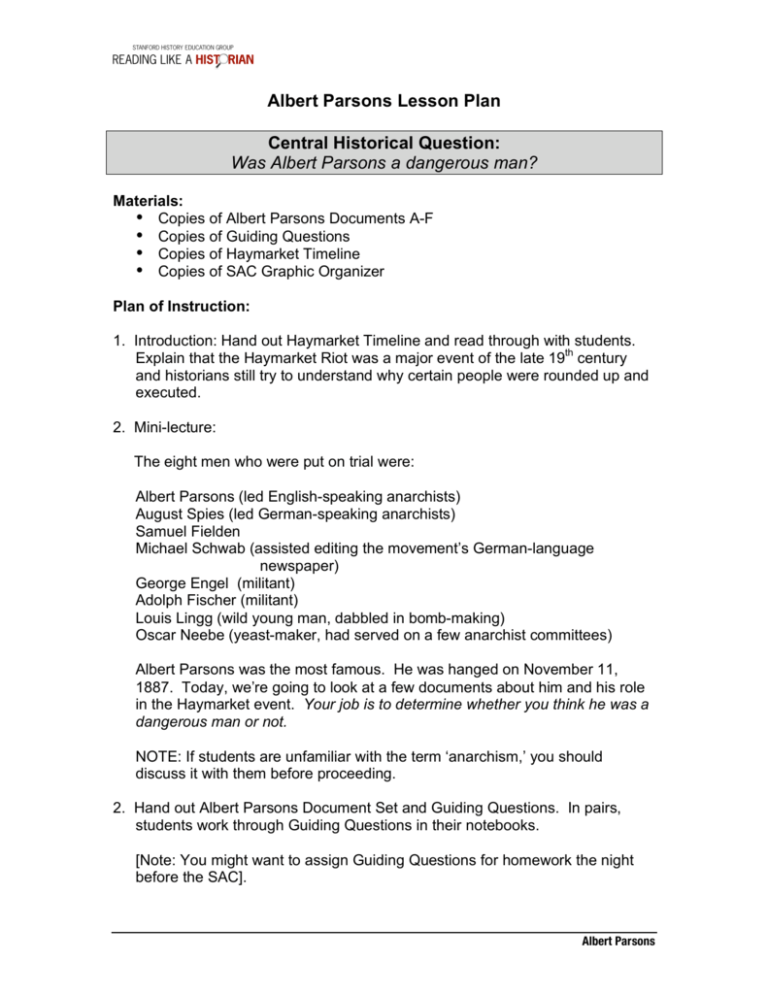
Albert Parsons Lesson Plan Central Historical Question: Was Albert Parsons a dangerous man? Materials: • Copies of Albert Parsons Documents A-F • Copies of Guiding Questions • Copies of Haymarket Timeline • Copies of SAC Graphic Organizer Plan of Instruction: 1. Introduction: Hand out Haymarket Timeline and read through with students. Explain that the Haymarket Riot was a major event of the late 19th century and historians still try to understand why certain people were rounded up and executed. 2. Mini-lecture: The eight men who were put on trial were: Albert Parsons (led English-speaking anarchists) August Spies (led German-speaking anarchists) Samuel Fielden Michael Schwab (assisted editing the movement’s German-language newspaper) George Engel (militant) Adolph Fischer (militant) Louis Lingg (wild young man, dabbled in bomb-making) Oscar Neebe (yeast-maker, had served on a few anarchist committees) Albert Parsons was the most famous. He was hanged on November 11, 1887. Today, we’re going to look at a few documents about him and his role in the Haymarket event. Your job is to determine whether you think he was a dangerous man or not. NOTE: If students are unfamiliar with the term ‘anarchism,’ you should discuss it with them before proceeding. 2. Hand out Albert Parsons Document Set and Guiding Questions. In pairs, students work through Guiding Questions in their notebooks. [Note: You might want to assign Guiding Questions for homework the night before the SAC]. Albert Parsons 3. Put students in groups of 4. Within each group, one pair should be Team A and one should be Team B. Explain SAC procedures as outlined on SAC Graphic Organizer. A SAC is NOT a debate, each group presents its side and the other group has to listen. 4. In pairs, students come up with evidence to support their claim and begin filling out the SAC Graphic Organizer. 5. TEAM A presents their side to TEAM B. TEAM B listens and repeats back the argument to TEAM A. 6. TEAM B presents their side to TEAM A. TEAM A listens and repeats back their argument to TEAM B. 7. Groups of four try to reach consensus. 8. Discussion: Groups report out. Was Parsons dangerous? Why or why not? Citations: U.S. Congress, House, Investigation by a Select Committee of the House of Representatives relative to the Causes of the General Depression in Labor and Business etc, 45th Cong. 3d. Session, Mis. Doc. No. 29 (Washington D.C.: Government Printing Office, 1879). Albert R. Parsons, “What is Anarchism?” Anarchism: Its Philosophy and Scientific Basis, as Defined by Some of its Apostles (Chicago, 1887). Reprinted in Dave Roediger and Franklin Rosemont, eds. Haymarket Scrapbook (Chicago: Charles H. Kerr Publishing Company, 1986), 27–28. Caleb Crain, The Terror Last Time: What Happened at Haymarket? The New Yorker, March 13, 2006. http://www.newyorker.com/archive/2006/03/13/060313crbo_books The Anarchists’ Trial; New Witness Strengthen the Prosecution, from http://query.nytimes.com/gst/abstract.html?res=9D05E0D91030E533A2575BC2A9619C 94679FD7CF Lucy Parsons, Life of Albert R. Parsons, (Chicago: 1889), 211–212. Dyer D. Lum, The Great Trial of the Chicago Anarchists, (Socialistic Publishing Co., 1886), 112-113. http://lincoln.lib.niu.edu/file.php?file=lum.html © Copyright 2009, Avishag Reisman and Bradley Fogo. Albert Parsons Document A (Modified) Congress has the power, under the Constitution, to pass an 8-hour workday. We ask it; we demand it, and we intend to have it. If the present Congress will not give it to us we will send men to Congress who will give it to us. . . . We do not propose to bring an industrial confusion or a state of anarchy, or to precipitate revolution or a state of anarchy, or to start revolution in this country. We are peaceable citizens, husbands, fathers. We are citizens of the State and law-abiding men. . . . The working classes simply seek to improve their condition. This is a natural feeling, and I cannot say that there is anything unnecessarily criminal in such a desire. We simply want less work and more pay, knowing that only through short hours and high wages can our condition be improved. We know this, and so we struggle for it. We wish to get at it by degrees. . . . Vocabulary Precipitate—bring about suddenly Source: The document above is from Albert Parsons’ testimony to the House of Representatives Select Committee on Causes of the General Depression in Labor and Business, 1879. Albert Parsons Document B (Modified) What, then, is our offense, being anarchists? The word anarchy is derived from the two Greek words an, meaning no, or without, and arche, government; hence anarchy means no government. Anarchy means a society which has no king, emperor, president or ruler of any kind. The purpose, the only purpose of capital [business owners] is to take away the product of the wage-workers. The origin of government was in violence and murder. Government enslaves the governed. Government is for slaves; free men govern themselves. . . The right to live, to equality of opportunity, to liberty and the pursuit of happiness, is yet to be acquired by the workers. . . . Capital and government stand or fall together. They are twins. The liberty of labor makes the government not only unnecessary, but impossible. When the people—the whole people—become the government, that is, participate equally in governing themselves, the government ceases to exist. . . Anarchy, therefore, is liberty; is the negation of force, or compulsion, or violence. Anarchy would strike from humanity every chain that binds it, and say to mankind: "Go forth! you are free! Have all, enjoy all!" Vocabulary Negation—absence Source: In this article, written in 1887, Albert Parsons explains what anarchism means to him. The article appears in a book called Anarchism: Its Philosophy and Scientific Basis, as Defined by Some of its Apostles. Albert Parsons Document C (Modified) The anarchists were indeed fond of dynamite, then a recent invention. Its main ingredient, nitroglycerin, had been around since the 1840s, but not until Alfred Nobel found a way to stabilize it, by mixing it with an inert filler, did it become safe enough for widespread use. “If we would achieve our liberation,” Parsons had told a crowd of protesters in April of 1885, “every man must lay by a part of his wages, buy a Colt’s navy revolver, a Winchester rifle, and learn how to make and use dynamite.” “Dynamite is the diffusion of power,” Parsons explained at the trial. “It is democratic; it makes everybody equal.” Vocabulary Diffusion—spreading out Source: The excerpt above is from a review of James Green’s 2006 book, Death in the Haymarket. Document D (Modified) The Anarchists’ Trial New Witnesses Strengthen the Prosecution Testify to the Incendiary Speeches At the Anarchist trial this morning a newspaper reporter testified that Parson in his speech said: “What good are those strikes going to do? What do you think you are going to gain by them? Do you think you are going to gain your point? No, you will have to go back to work for less wages than you formerly received. . . .It is. . . the system that ought to be destroyed.” Detective Cosgrove also testified about Parsons’s speech. He estimated the crowd at 2,000 and said it was very unruly and excited. Parsons near the close of his speech frequently cried “To arms,” which served to greatly increase the excitement. Source: The article above was published in the New York Times on July 28, 1886. Albert Parsons Document E (Modified) Cook County Bastille, Cell No. 29, Chicago, August 20, 1886. My Darling Wife: Our verdict this morning cheers the hearts of tyrants throughout the world. There was no evidence that any one of the eight doomed men knew of, or advised, or abetted the Haymarket tragedy. But what does that matter? The privileged class demands a victim, and we are offered a sacrifice to appease the hungry yells of an infuriated mob of millionaires who will be contented with nothing less than our lives. Monopoly triumphs! Well, my poor, dear wife, I, personally, feel sorry for you and the helpless little babes. My children—well, their father had better die in the effort to secure their liberty and happiness than live contented in a society which condemns nine-tenths of its children to a life of wage-slavery and poverty. Bless them; I love them unspeakably, my poor helpless little ones. Ah, wife, living or dead, we are as one. For you my affection is everlasting. For the people, humanity. I cry out again and again in the doomed victim’s cell: Liberty! Justice! Equality! Albert R. Parsons Vocabulary Abetted—encouraged or supported Appease—calm or satisfy Source: Parsons wrote the letter above to his wife while in jail. He was awaiting trial for his role in the Haymarket Riot. Albert Parsons Document F (Modified) “When I judged that Mr. Parsons was about to end his speech I went over to the station, spoke to Captain Bonfield and decided to go home, but instead of going immediately I went back to hear a little more; stayed there about five minutes longer and then left. Within about twenty minutes from the time that I left the meeting I heard the sound of the explosion of the bomb at my house. . . I did in fact take no action at the meeting about dispersing it. There were occasional replies from the audience as ‘shoot him,’ ‘hang him,’ or the like, but I do not think from the directions in which they came, here and there and around, that there were more than two or three hundred actual sympathizers with the speakers. Several times cries of ‘hang him,’ would come from a boy in the outskirts, and the crowd would laugh. I felt that a majority of the crowd were idle spectators, and the replies nearly as much what might be called ‘guying’ as absolute applause. Some of the replies were evidently bitter; they came from immediately around the stand. The audience numbered from 800 to 1,000. . . . There was no suggestion made by either of the speakers for the immediate use of force or violence toward any person that night; if there had been I should have dispersed them at once. When I went to the station during Parson's speech, I stated to Captain Bonfield that I thought the speeches were about over; that nothing had occurred yet or looked likely to occur to require interference, and that he had better issue orders to the police at the other stations to go home, I don't remember hearing Parsons call ‘To arms! To arms! To arms!’" Vocabulary Dispersing—scattering; breaking up Guying- teasing; ridiculing Source: Mayor Harrison of Chicago actually attended the demonstration, but left right before the violence erupted. He gave his testimony at the trial on August 2, 1886. Albert Parsons Guiding Questions Name_______________ Document A 1. What words does Parsons use to describe the workers and their needs? How do these words make the workers sound? Why do you think he chose these words? 2. Parsons says, “We wish to get at it by degrees.” Does this statement make him seem more radical or more moderate? 3. When was this document written? How many years before the Haymarket incident? Do you think it’s a reliable account of Parsons’ beliefs? Document B 4. How does Parsons define anarchism? Does it sound like a positive or negative thing? Who might disagree with this characterization of anarchism? 5. When was this written? Was it before or after the Haymarket incident? 6. What was Parsons’ purpose in writing this document? Document C 7. According to Parsons, is dynamite a positive or negative thing? Why? 8 How might Parson’s opinion of dynamite affect what people thought about him? Document D 9. According to Detective Cosgrove, what was the effect of Parsons’ speech? 10. Do you think this is a reliable acocunt of Parsons’ speech? Why or why not? Document E 11. According to Parsons, why are he and the other defendants being tried? 12. What does Parsons mean when he claims “monopoly triumphs?” 13. Based on this letter, how would you describe Parsons? Document F 14. Was Mayor Harrison afraid of Parsons when he heard him speak? How do you know? 15. How does the Mayor’s account differ from Detective Cosgrove’s account in Document D? Which do you find more reliablie—Document D or F? Albert Parsons Structured Academic Controversy: Albert Parsons and the Haymarket Riot Albert Parsons was the most famous man arrested in the Haymarket Riots. He was hanged on November 11, 1887. Your job is to determine whether you think he was a dangerous man or not. During today’s class, you will work in teams to discuss arguments convicting and defending Albert Parsons. Your goals for today should include looking at all the issues, seeing both sides, and finding common ground. SAC QUESTION During the SAC, you and your group will try to answer the following question: Was Albert Parsons a dangerous man? Team A will argue: YES, Albert Parsons was a dangerous man. Team B will argue: NO, Albert Parsons was not a dangerous man. EVIDENCE As you develop your arguments for the SAC, use as much evidence as you can. PROCEDURE 30 minutes With your teammate, read the documents in the Haymarket document set. Find four pieces of evidence which support your side. 10 minutes Team A presents. BOTH PARTNERS MUST PRESENT!!! Team B writes down Team A’s arguments and then repeats them back to Team A. 10 minutes Team B presents. BOTH PARTNERS MUST PRESENT!!! Team A down arguments of Team B and then repeats them back to Team B. 10 minutes Everyone CAN ABANDON their positions. Group of 4 attempts to develop a consensus. Albert Parsons ORGANIZING THE EVIDENCE Name_____________ Use this space to write your main points and the main points made by the other side. Albert Parsons was a dangerous man: List 4 main points/evidence that support this side. 1) From Document _____: 2) From Document _____: 3) From Document _____: 4) From Document _____: Albert Parsons was not a dangerous man: List 4 main points/evidence that support this side. 1) From Document _____: 2) From Document _____: 3) From Document _____: 4) From Document _____: Albert Parsons Coming to Consensus STARTING NOW, YOU MAY ABANDON YOUR ASSIGNED POSITION AND ARGUE FOR EITHER SIDE. Use the space below to outline your group’s agreement. Your agreement should address evidence and arguments from both sides. Albert Parsons
